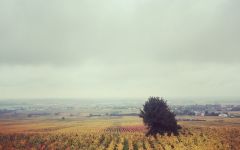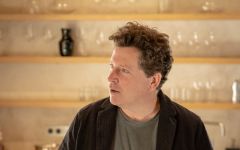Olivier Bernstein Clos Vougeot Grand Cru 2013



Product Details
Your Rating
Somm Note
Winemaker Notes
The wine is firm, powerful and develops aromas of ripe black fruit. It may not be approachable in youth, thanks to its tighter tannic structure, but it conceals an amazing complexity and great minerality that just needs time to express itself.
Other Vintages
2017- Decanter
-
Wine
Spectator
-
Wine
Spectator





Born in Touraine, Bernstein’s family business is rooted not in wine but in classical music. His grandfather founded Barenreiter, a publishing company famous for its scores by world-renowned composers such as Mozart, Bach and Schubert, and Bernstein grew up in a home where creativity and flair were valued alongside hard work. Olivier’s early business ventures took him into the rail industry working with TGV, but despite travelling the world to work both far (Taiwan and Venezuela) and near (Cassel in Germany) the pull of his desire to become a winemaker meant he returned to France. Taking his first formal steps towards fulfilling this ambition, Bernstein undertook a degree in viticulture in Beaune. “I needed to grow something for myself,” he says. “I had a precise goal: an ambition to make pure, balanced wines that combine both mouth-filling depth and magnificent delicacy.”
At the age of 35, he moved to the south of France (Tautavel, Roussillon) and acquired eight hectares of vineyard. “I bought a tractor and started out by doing everything by myself, learning viticulture and learning the industry. It was complicated, it was hard work but the successes were so rewarding,” Bernstein says. “My dream, though, was always Burgundy, and I made the move there in 2007.” Starting from scratch again, Bernstein began by renting space in Gevrey-Chambertin. It was here that he met Richard Seguin, the man who would later become his cellar master: “We began talking while sorting grapes – we were both the only people working a Sunday!” says Bernstein. In 2008, Seguin came to join Bernstein full-time. “I was lucky with the timing of my move,” says Bernstein. “I was able to take on some really interesting vineyards with wonderful old vines. Now, whether working on the vineyards I own, or those we rent, I am able to farm entirely as I want to. We do all the viticulture ourselves. The whole process from the vineyard to the bottle lasts around 30 months, during which we have a thousand decisions to make which will influence the wine – in those choices, there must be no compromise,” he explains.
In 2012 Olivier Bernstein was able to purchase vines in the Gevrey-Chambertin 1er Cru vineyard Les Champeaux and the Grand Cru Mazis-Chambertin. He has also settled into his fabulous premises in the heart of Beaune, an essential visit for the serious lover of Bernstein wines.
Today, Bernstein’s seven Grands Crus and three Premiers Crus plots have a wealth of old vines, which are fundamental to the quality of his wines. All but one of the Bernstein vineyard plots are at least 40 years old; most are between 60 and 80 years-old. While officially acting with negociant status, Olivier and his team take responsibility for the vineyard work on their plots.

Thin-skinned, finicky and temperamental, Pinot Noir is also one of the most rewarding grapes to grow and remains a labor of love for some of the greatest vignerons in Burgundy. Fairly adaptable but highly reflective of the environment in which it is grown, Pinot Noir prefers a cool climate and requires low yields to achieve high quality. Outside of France, outstanding examples come from in Oregon, California and throughout specific locations in wine-producing world. Somm Secret—André Tchelistcheff, California’s most influential post-Prohibition winemaker decidedly stayed away from the grape, claiming “God made Cabernet. The Devil made Pinot Noir.”

Containing the largest Grand Cru in all of the Côte d’Or, Vougeot, the village, takes its name from the small stream flowing through it, called Vouge. Over three quarters of the village retains Grand Cru status, and a single vineyard at that: Clos de Vougeot (or simply, Clos Vougeot). Its mass—over 50 ha—retains the single name chiefly for historic reasons.
But today, Clos de Vougeot contains over 80 owners and shows significant soil and slope variations within its boundaries. The top, bordering Musigny and Grands Echezeaux, is calcareous and gravelly on oolitic limestone and exhibits wonderful drainage. The middle sections are limestone, gravel and clay with less of a slope. The lower part has little slant and is mostly made of clay. Historically the diverse parcels were blended but today the abundance of owners means that everyone has his own style. Exploring and understanding them is part of the allure of Clos de Vougeot.
In general a fine Clos de Vougeot when young will be dense and dark but juicy, with a pronounced austerity, and needs a good ten years to bring it to its full potential.
